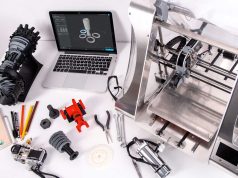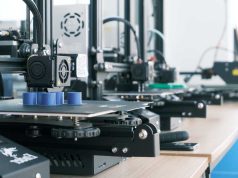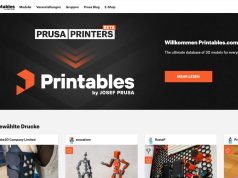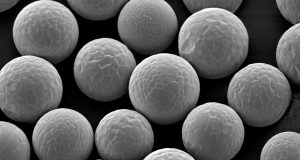Basis: The digital 3D Model
Table of Contents
The principle can be compared to glueing a certain number of coasters (layers) on top of each other in order to create a coaster-cube (=3D object).
Current Printing Methods
Additive Manufacturing (AM) describes numerous technical methods, which were categorised by the ASTM International into the following in 2012: vat photopolymerisation, material jetting, binder jetting, material extrusion, powder bed fusion, sheet lamination and directed energy deposition. Some of these methods are principally identical and only distinguishable by a few changes, which were partially patented by companies. Broadly speaking we can differentiate between the following processes:
1. 3D Printing with Powder (3DP)
A very advanced method from the field of “Additive Layer Manufacturing” uses powder as base for 3D printing. Such a printer is equipped with one or more print heads, which are similar in their function to a conventional ink-jet printer. However instead of ink, a liquid glue (binder) is applied on a powder bed. The single 2D layers of a sliced 3D model serve as data input. Using this technology, the first (bottom) layer is applied on a powder bed by a moving print head containing liquid glue. By doing this, the 3D printer draws the 2D picture of the first layer into the powder bed and binds the particles. Afterwards a new, paper-thin powder layer is applied on top of the first “picture” by the squeegee tool and the process repeats itself. Applying layer by layer the 3D model finally comes to life by binding the powder particles. In order for the object to grow from the bottom upwards, the powder bed moves downwards each time by the hight of the new layer applied (z axis). The quantity of material used is calculated so that layers will bind between each other as well. Powder and binding material can be made of different kinds of materials. Gypsum is primarily being used in combination with plastic powder, however, ceramic, glass and other powdered material can be processed as well.
One of the major benefits of this technique is the possibility to create overhanging structures. The powder which is not being fused serves as a supporting structure for overhangs and hollows at the same time. Additionally this method is very resource-saving as the loose powder is being removed using an air pistol and after sieving can be re-cycled for the next print. Using coloured binding agents and multiple print heads, coloured objects can be created. Devices functioning according to this principle are more expensive than FFF devices at the moment (see below). In most cases a finishing process is required. Objects become solid and are protected against moisture by being immersed into liquid (infiltration). The resolution is limited and depends on the grain size of the powder.
1.1. Selective Laser Sintering (SLS)
The Selective Laser Sintering (commercially available on the market as Selective Laser Melting (SLM), by SLM Solutions) works in a similar way as the 3DP method as it is also based on powder material. In contrast, the single layers are not joined by a binding agent, but with the aid of a high-performance laser (CO2 laser) under protective atmosphere. Besides plastic, other materials like metals, ceramics and sand can be processed.
1.2. Electron Beam Melting (EBM)
EBM works on a similar principle with the only difference that objects are being manufactured by melting metal powder with an electron beam in a vacuum. The vacuum prevents air pockets resulting in the production of complex solid metal objects. This technology also allows for processing metals with a higher melting point e.g. titanium. Commonly EBM devices achieve a poorer resolution compared to SLS devices, however, the time required to print a job increases.
2. 3D printing employing melted materials
Fused Filament Fabrication (FFF), e.g. Fused Deposition Modelling (FDM)
Printing with melted materials is one of the most popular methods, especially plastics like ABS or PLA are widely used. It is currently one of the least expensive technologies to manufacture 3-diamensial objects.
Fundamentally this method works like a hot glue gun. Based on above mentioned materials, the object is printed onto a moveable and heated build plate. The heated build surface prevents prints from warping and allows adherence of the bottom layer. The print head is a heated extruder, which melts the thermoplastics used (filament spool). Depending on the model, either the nozzle itself and/or the build plate is moved. The printing speed has to be adjusted, so that the layer of the material used can cool down before the next one is applied. Besides the characteristic of the digital model, the printing quality highly depends on the precision of movements, the fineness of the nozzle and the thermal property of the material itself. Adding further extruders and coloured material allows the creation of multi-coloured objects. To create overhanging structures, an additional extruder using support material is required. Cavities and support structures can be printed with water-soluble or waxy materials, that can be washed out or rendered.
This Technology especially gained in importance by the open hardware project RepRap (www.reprap.org). After construction plans had been made public in the course of this project, the concept was refined by some companies. Almost all popular and affordable 3D printers are based on this principle and descend from RepRap projects, e.g. printers from Makerbot, Bits from Bytes and Ultimaking. Lately the printing quality has been enhanced by continuously improving the software, electronics, materials, extruder and the 3-dimensional control.
The principle of extrusion of this method can be applied to other viscous materials like foods, concrete, gypsum and similar.
The open hardware project Fab@HOme (www.fabathome.org) offers constructions plans for suchlike devices.
3. 3D printing with liquid materials
Another major method is based on liquid UV-sensitive synthetics (photopolymeres).
3.1. Stereolithography (SLA, SL)
This method of production is based on a pool filled with liquid photopolymer. The special characteristic of this plastic is that it solidifies after a certain period of exposure to light. To create an object based on this method, the single layers of a 3D model are laser-projected onto the surface of the liquid material, which is positioned on a moveable printing bed. The first layer hardens and therefor adheres to the platform. Then the build plate descends by a hight equal to the thickness of a single layer and liquid material accumulates on top. Now the second layer is being projected and the process repeats itself. Once the model is finished, it is taken out of the liquid and cured in an UV chamber. Compared to other methods, this one is more expensive due to the cost of material but can achieve a higher printing quality depending on the material and laser. Support structures are being added during the printing process and must be removed manually afterwards. By now affordable, desktop-sized devices are available on the market. Mixed materials like ceramics-photopolymer mixtures can also be processed. During the following burning process ceramic particles are fused and synthetics are burned out.
3.2. Digital Light Processing (DLP)
The DLP method is based on the same principle as stereolithography, except that a DLP-projector is serving as source of light. Latest projects available as open source were created by using an off-the-shelf beamer.
3.3. Multi Jet Modelling (MJM)
Known as MJM on the market, this method is a mixture of stereolithography and FDM. Thereby a liquid, light-sensitve plastic is being applied on a platform by the print head. The light source integrated in the head cures the material immediately. Therewith extremely detailed objects can be manufactured. Further print heads create support structures for overhangs, which have to be removed mechanically or washed out after the printing process. Known as “digital materials”, several different plastics that can be mixed are available.
3.4. Film Transfer Imaging Process (FTI)
Similar to the above methods is the Film Transfer Imaging Process by 3D Systems. A layer of a liquid and light-sensitive material is applied on a build plate and cured by a projector.
4. Further Methods
Further Methods of additive manufacturing include laser deposition welding and Laminated Object Manufacturing (LOM). Thereby layers of adhensive-coated paper or foils are glued on top of each other and cut into the desired shape by an automated cutter.
<< Part 1: Development and History of 3D Printing Technologies
(c) The copyright of this article is held by 3Printr.com. No part of it may be reproduced, embodied or published (with exception of setting links to our site) without the prior written permission of the publisher. The articles were scientifically prepared do not intended to be exhaustive but are provided for guidance. Misprints, typing errors and any content-related errors reserved.
Subscribe to our Newsletter
3DPResso is a weekly newsletter that links to the most exciting global stories from the 3D printing and additive manufacturing industry.




















